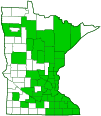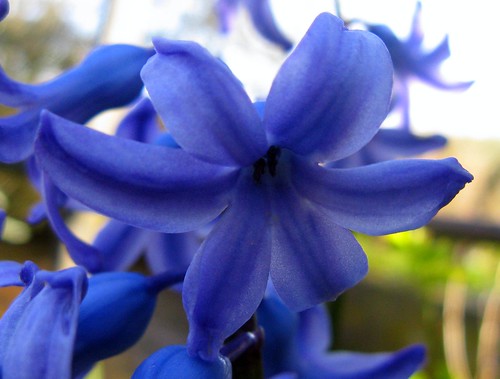Siberian squill
(Scilla siberica)
Conservation • Weed • Description • Habitat • Ecology • Use • Distribution • Taxonomy
Description |
||
Siberian squill is an erect, perennial forb that rises from a small bulb and fibrous roots. It can be 4″ to 8″ tall, but is usually no more than 6″ in height. The bulb is egg-shaped and ⅝″ to ¾″ long. The outer coating of the bulb is dark purplish-brown. It often forms colonies. In the early spring a rosette of 2 to 4 leaves and 1 to 4 flowering stems (scapes) rises from the top of the bulb. The leaves are broadly linear, 4″ to 6″ long, and ⅝″ to ¾″ wide. They are folded longitudinally in the lower half and usually rolled upward longitudinally in the upper half. They taper to a blunt point at the tip. The upper surface and lower surfaces are hairless. The margins are untoothed. The scapes are erect, green or purplish-green, angled, unbranched, leafless, and hairless. The inflorescence is a solitary flower or a cluster of 2 to 4 flowers at the tip of the scape. The flowers nod downwards at the end of a 5 ⁄16″ to ½″ long flower stalk. There is a single, minute, egg-shaped modified leaf (bract) at the base of the flower head. None of the bracts are replaced with bulblets. The flowers are about 1″ in diameter when fully open. There are 3 petals and 3 petal-like sepals (6 tepals), 6 stamens, and 1 style. The tepals are narrowly oblong, ½″ to ⅝″ long, 3 ⁄16″ to ¼″ wide, and spreading. They have a deep blue central vein and fade to purple toward the margins. The stamens have white filaments and blue anthers. The style is purple and is not divided at the tip. The flowers are strongly fragrant. In North America the plant propagates vegetatively, rarely if ever producing fruit. |
||
Height |
||
4″ to 8″ |
||
Flower Color |
||
Deep blue to purple |
||
Similar Species |
||
| No similar species | ||
Habitat |
||
Moderate moisture. Deciduous woodlands, railroads, disturbed areas. Partial sun. |
||
Ecology |
||
Flowering |
||
March to early May |
||
Pests and Diseases |
||
|
||
Toxicity |
||
The leaves of Siberian squill are toxic to mammals, including humans. |
||
Use |
||
|
||
Distribution |
|||||||||||||||||||
|
|||||||||||||||||||
Nativity |
|||||||||||||||||||
Native to eastern Europe and Asia. Introduced, cultivated, rarely escaped cultivation, and naturalized in North America. |
|||||||||||||||||||
Occurrence |
|||||||||||||||||||
Uncommon |
|||||||||||||||||||
Taxonomy |
|||
| Kingdom | Plantae (Plants) | ||
| Division | Tracheophyta (Vascular Plants) | ||
| Subdivision | Spermatophytina (Seed Plants) | ||
| Class | Liliopsida (Monocots) | ||
Order |
Asparagales (Agaves, Orchids, Irises, and Allies) | ||
Family |
Asparagaceae (agave and allies) | ||
| Subfamily | Scilloideae | ||
| Tribe | Hyacintheae | ||
| Subtribe | Hyacinthinae | ||
Genus |
Scilla (squill) | ||
Subordinate Taxa |
|||
Four subspecies of Siberian squill, including the nominate subspecies, ssp. siberica, occur in eastern Europe. Only the nominate subspecies occurs in North America. When the nominate infraspecies is the only one occurring in North America, North American taxonomies usually drop the infraspecies epithet. Consequently, Scilla siberica ssp. siberica becomes simply Scilla siberica in North America. |
|||
Synonyms |
|||
Othocallis siberica Scilla sibirica (spelling error?) |
|||
Common Names |
|||
Siberian squill |
|||
Glossary
Bract
Modified leaf at the base of a flower stalk, flower cluster, or inflorescence.
Filament
On plants: The thread-like stalk of a stamen which supports the anther. On Lepidoptera: One of a pair of long, thin, fleshy extensions extending from the thorax, and sometimes also from the abdomen, of a caterpillar.
Linear
Long, straight, and narrow, with more or less parallel sides, like a blade of grass.
Scape
An erect, leafless stalk growing from the rootstock and supporting a flower or a flower cluster.
Sepal
An outer floral leaf, usually green but sometimes colored, at the base of a flower.
Tepal
Refers to both the petals and the sepals of a flower when they are similar in appearance and difficult to tell apart. Tepals are common in lilies and tulips.
Visitor Photos |
|||||
Share your photo of this plant. |
|||||
| This button not working for you? Simply email us at info@MinnesotaSeasons.com. Attach one or more photos and, if you like, a caption. |
|||||
|
|||||
MinnesotaSeasons.com Photos |
|||||
Plant |
|||||
 |
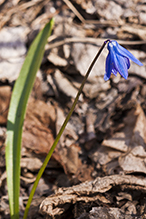 |
||||
Flower |
|||||
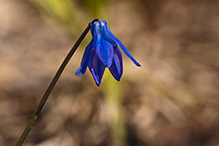 |
|||||
Leaves |
|||||
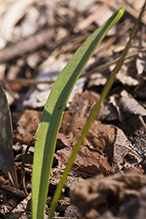 |
|||||

Visitor Videos |
|||
Share your video of this plant. |
|||
| This button not working for you? Simply email us at info@MinnesotaSeasons.com. Attach a video, a YouTube link, or a cloud storage link. |
|||
Other Videos |
|||
| Siberian squill ( Scilla siberica ) Seppo Sallinen |
|||
About
Published on May 8, 2012 Sony HDR-PJ10E. |
|||
| Scilla siberica wander van laar |
|||
About
Published on Mar 16, 2014
|
|||
| Scilla siberica wander van laar |
|||
About
Published on Mar 29, 2014
|
|||
| Spring Bee's Blue Pollen - Siberian Squill JCVdude |
|||
About
Uploaded on Apr 9, 2011 Bee's Blue Pollen. Early April has the bee's out and busy gathering colorful pollen, but blue? Could be some blue honey coming soon. Music Promises by Zero-project http://creativecommons.org/licenses/by-sa/3.0/ |
|||
| Skilla Seppo Sallinen |
|||
About
Published on May 7, 2012 Sony HDR-PJ10E. Seppo Sallnen. Idänsinililja ( Scilla siberica ), Skilla, Rysk Blåstjärna, Sibirischer Blaustern, Cebulica syberyjska, Russeblåstjerne, Oosterse sterhyacint, Scille de Sibérie, Siperiansinililja, |
|||

Visitor Sightings |
|||||
Report a sighting of this plant. |
|||||
| This button not working for you? Simply email us at info@MinnesotaSeasons.com. Be sure to include a location. |
|||||
|
|||||
MinnesotaSeasons.com Sightings |
|||||

|
Created: Last Updated: © MinnesotaSeasons.com. All rights reserved. |

